-
Countries
-
Data and Analysis
-
Special Focus
-
Crisis Responses
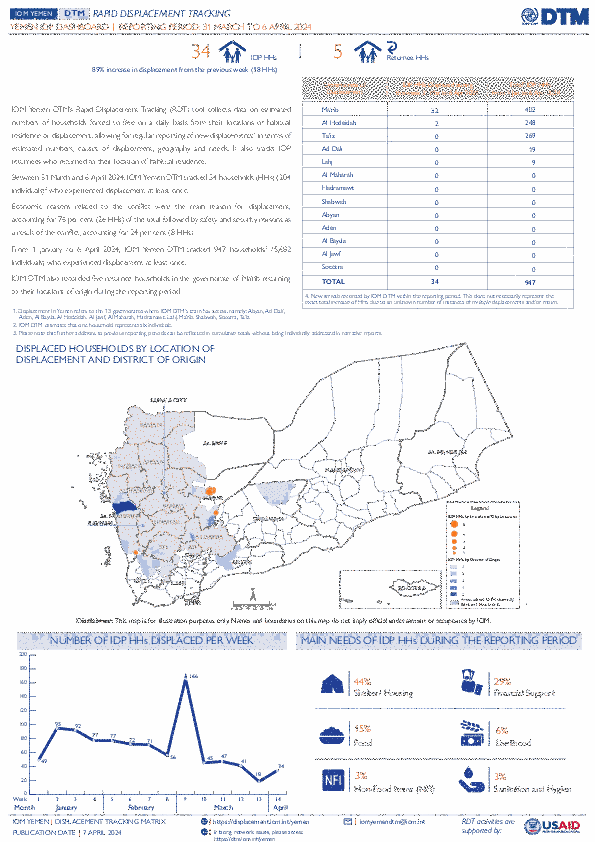
Contact
DTM Yemen, iomyemendtm@iom.int
Language
English
Location
Yemen
Period Covered
Mar 31 2024
Apr 06 2024
Activity
- Mobility Tracking
- Event Tracking
IOM Yemen DTM’s Rapid Displacement Tracking (RDT) tool collects data on estimated numbers of households forced to flee on a daily basis from their locations of origin or displacement, allowing for regular reporting of new displacements in terms of estimated numbers, geography, and needs. It also tracks returnees who returned to their location of origin.
From 1 January to 6 April 2024, IOM Yemen DTM tracked 947 households (HH) (5,682 Individuals) who experienced displacement at least once.
Between 31 March and 6 April 2024, IOM Yemen DTM tracked 34 households (204 individuals) displaced at least once. The majority of people moved into/within the following governorates and districts:
- Ma’rib (32 HHs) – Ma’rib City (17 HHs), Ma’rib (10 HHs), Harib (5 HHs) districts. Most displacements in the governorate originated from Al Hodeidah and Ma’rib.
- Al Hodeidah (2 HHs) – Hays (2 HHs) district. All displacements in the governorate originated from Ta’iz.
The majority of people moved from the following governorates and districts:
- Al Hodeidah (9 HHs) – Bajil (5 HHs), Az Zaydiah (2 HHs), At Tuhayta (2 HHs) districts.
- Ta’iz (5 HHs) – Maqbanah (2 HHs), Jabal Habashi (1 HH), Sharab As Salam (1 HH) districts.
- Ma’rib (5 HHs) – Al Abdiyah (3 HHs), Harib (1 HH), Raghwan (1 HH) districts.
IOM identified 9 households displaced in the previous reporting period, which covered 24 - 30 March 2024, in the governorates of Ma'rib (6 HHs), Al Hodeidah (2 HHs), and Ta’iz (1 HH). These figures have been added to the cumulative displacement total recorded since the beginning of the year.
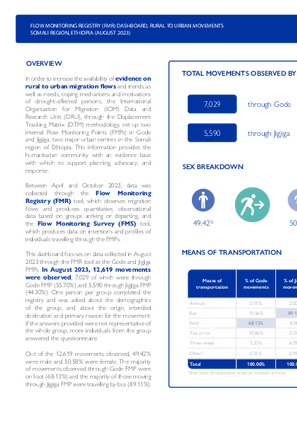
Contact
DTM Ethiopia, DTMEthiopia@iom.int
Language
English
Location
Ethiopia
Period Covered
Aug 01 2023
Aug 31 2023
Activity
- Flow Monitoring
In order to increase the availability of evidence on rural to urban migration flows and trends, as well as needs, coping mechanisms and motivations of drought-affected persons, the International Organization for Migration (IOM) Data and Research Unit (DRU), through the Displacement Tracking Matrix (DTM) methodology, set up and piloted two internal Flow Monitoring Points (FMPs) in Gode and Jigjiga, two major urban centres in the Somali region of Ethiopia. The pilot ran from June 2023 through August 2023.
This dashboard focuses on data collected in August 2023 through the FMR tool in Gode and Jigjiga FMPs. In August 2023, 12,619 movements were observed, 7,029 of which were through Gode FMP (55.70%) and 5,590 through Jigjiga FMP (44.30%).

Contact
DTM Ethiopia, DTMEthiopia@iom.int
Language
English
Location
Ethiopia
Period Covered
Feb 01 2024
Feb 29 2024
Activity
- Flow Monitoring
In February 2024, a total of 36,277 movements were observed across the six flow monitoring points (FMPs) in Ethiopia. This represents a 4.2% decrease in daily average movements in comparison with January 2024 when an average of 1,305 movements per day were observed.
The ratio between outgoing movements (63%) during February and incoming movements (37%) remained the same as the previous month. A total of 22,762 outgoing movements were observed, out of which 10,954 (48.1%) were heading to Saudi Arabia, 4,689 (20.6%) were going to Kenya, 2,029 (8.9%) to Djibouti, 1,367 (6%) to Somalia, 1,105 (4.9%) to South Africa, 859 (3.8%) to Yemen, and 668 (2.9%) to Sudan, while remaining movements were heading to other Southern African, Middle Eastern, North American and European countries.
At the same time, 13,515 incoming movements were observed, out of which 8,763 (64.9%) originated from Sudan, while 2,276 (16.8%) came from Kenya, 1,393 (10.3%) from Djibouti, 790 (5.8%) from Somalia and 293 (2.2%) came from other Middle Eastern and African countries. Most incoming movements were by Ethiopians (67.1%), followed by Sudanese nationals (31.4%). Returning Ethiopians departed from Sudan (48%), Kenya (25%), Djibouti (15.1%), Somalia (8.7%), Yemen (2%), Saudi Arabia (1.1%) and Tanzania (0.1%).

Contact
DTM Haiti, dtmhaiti@iom.int
Language
English
Location
Haiti
Period Covered
Apr 01 2024
Apr 04 2024
Activity
- Mobility Tracking
- Site Assessment
To continually inform humanitarian responses in the MAPAP sites, the CCCM cluster and DTM conduct regular data collections in these sites to update information on the displacement situation in the sites.
This report presents the situation as of 04 April 2024. A total of 87 sites are active in the MAPAP hosting 89,007 IDPs, this represents 0,3% more compared to 22 March
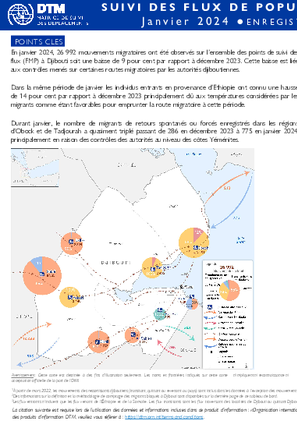
Contact
DTM Djibouti, DTMDjibouti@iom.int
Language
English
Location
Djibouti
Period Covered
Jan 01 2024
Jan 31 2024
Activity
- Flow Monitoring
En janvier 2024, 26 992 mouvements migratoires ont été observés sur l’ensemble des points de suivi des flux (FMP) à Djibouti soit une baisse de 9 pour cent par rapport à décembre 2023. Cette baisse est liée aux contrôles menés sur certaines routes migratoires par les autorités djiboutiennes. Dans la même période de janvier les individus entrants en provenance d’Ethiopie ont connu une hausse de 14 pour cent par rapport à décembre 2023 principalement dû aux températures considérées par les migrants comme étant favorables pour emprunter la route migratoire à cette période.
Durant janvier, le nombre de migrants de retours spontanés ou forcés enregistrés dans les régions d’Obock et de Tadjourah a quasiment triplé passant de 286 en décembre 2023 à 775 en janvier 2024, principalement en raison des contrôles des autorités au niveau des côtes Yéménites.

Contact
DTM Djibouti, DTMDjibouti@iom.int
Language
English
Location
Djibouti
Period Covered
Jan 01 2024
Jan 31 2024
Activity
- Flow Monitoring
In January 2024, 26,992 migratory movements were observed at all Djibouti's Flow Monitoring Points (FMPs) with a decrease of 9 per cent compared with December 2023. This drop is linked to the controls carried out on certain migration routes by the Djibouti authorities. During the same period in January, the number of people entering Djibouti from Ethiopia rose by 14 per cent compared with December 2023, mainly due to the temperatures which migrants consider to be favourable for taking the migration route at this time of year. During January, the number of spontaneous or forced returnees recorded in the Obock and Tadjourah regions almost tripled, rising from 286 in December 2023 to 775 in January 2024, mainly due to controls by the authorities on the Yemeni coast.
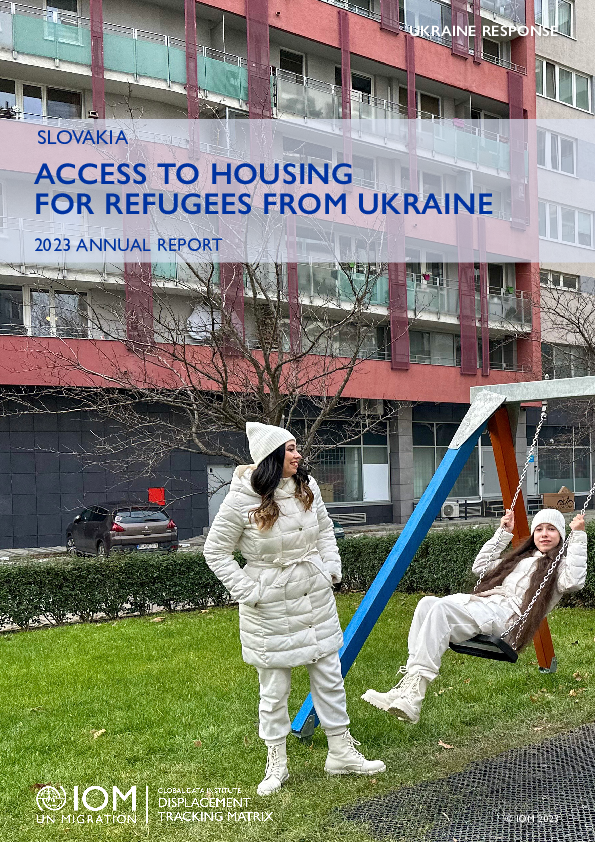
Contact
DTM Europe, DTMMediterranean@iom.int
Language
English
Location
Slovakia
Period Covered
Jan 01 2023
Dec 31 2023
Activity
- Survey
Key findings:
- 67% of respondents were living in individual housing and 33% in collective housing
- 16% of households had at least one infant (0-4 years old), 45% with at least one child (5-17 years old) and 31% with at least one elderly person (60+ years old).
- 14% were in need of support with accommodation
- 18% were in need of support with household goods
- 50% of respondents changed accommodation at least once while in Slovakia
- Key challenges in accessing housing include: overcrowdedness (42%), stress (15%) and lack of privacy (10%)
- 71% of respondents have received accommodation support
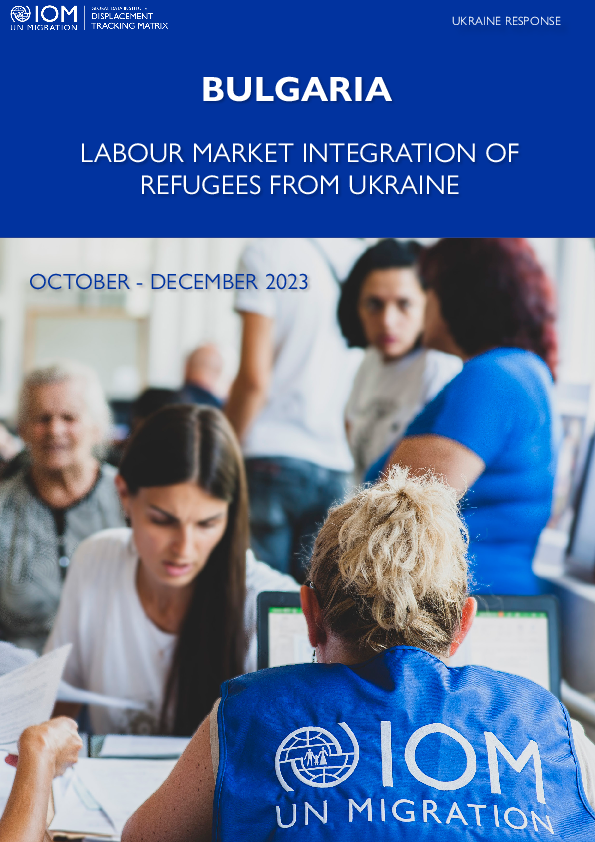
Contact
DTM Europe, DTMMediterranean@iom.int
Language
English
Location
Bulgaria
Period Covered
Oct 01 2023
Dec 31 2023
Activity
- Survey
Key Findings:
- Among respondents, 57 per cent are active (employed or unemployed), and 40 per cent are inactive (student status, parental leave, retirement, unemployment and not looking for a job).
- Within active population, 51 per cent are employed and 34 are unemployed, 9% were daily workers and 6% were self-employed.
- Key occupations after displacement are in professional roles (30%), services and sales (24%) and elementary occupations (13%)
- 75% of working-age stayers do not know the local language. Among working-age stayers without any knowledge of the local language (76%), 37 per cent are employed and 59 per cent are unemployed (4% unknown).
- 71% of male respondents were satisfied and 67% of female respondents were satisfied.
- Top reasons for unemployment and not looking for a job*: family duties (63%), medical conditions (11%), no need for job (10%).
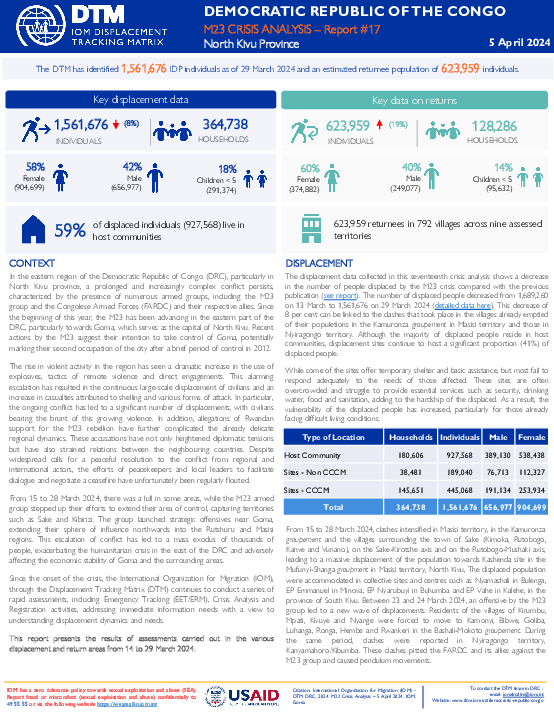
Contact
DTM DRC, iomdrcdtm@iom.int
Language
English
Location
Democratic Republic of the Congo
Period Covered
Mar 14 2024
Mar 29 2024
Activity
- Mobility Tracking
- Event Tracking
In the eastern region of the Democratic Republic of Congo (DRC), particularly in North Kivu province, a prolonged and increasingly complex conflict persists, characterized by the presence of numerous armed groups, including the M23 group and the Congolese Armed Forces (FARDC) and their respective allies. Since the beginning of this year, the M23 has been advancing in the eastern part of the DRC, particularly towards Goma, which serves as the capital of North Kivu. Recent actions by the M23 suggest their intention to take control of Goma, potentially marking their second occupation of the city after a brief period of control in 2012.
Since the onset of the crisis, the International Organization for Migration (IOM), through the Displacement Tracking Matrix (DTM) continues to conduct a series of rapid assessments, including Emergency Tracking (EET/ERM), Crisis Analysis and
Registration activities, addressing immediate information needs with a view to understanding displacement dynamics and needs. This report presents the results of assessments carried out in the various displacement and return areas from 14 to 29 March 2024.
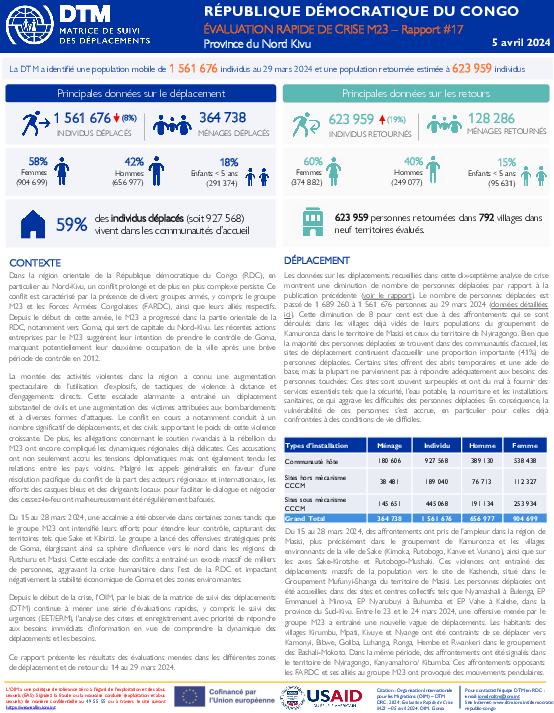
Contact
DTM DRC, iomdrcdtm@iom.int
Language
French
Location
Democratic Republic of the Congo
Period Covered
Mar 14 2024
Mar 29 2024
Activity
- Mobility Tracking
- Event Tracking
Dans la région orientale de la République démocratique du Congo (RDC), en particulier au Nord-Kivu, un conflit prolongé et de plus en plus complexe persiste. Ce conflit est caractérisé par la présence de divers groupes armés, y compris le groupe M23 et les Forces Armées Congolaises (FARDC), ainsi que leurs alliés respectifs. Depuis le début de cette année, le M23 a progressé dans la partie orientale de la RDC, notamment vers Goma, qui sert de capitale du Nord-Kivu. Les récentes actions entreprises par le M23 suggèrent leur intention de prendre le contrôle de Goma, marquant potentiellement leur deuxième occupation de la ville après une brève période de contrôle en 2012.
Depuis le début de la crise, l'OIM, par le biais de la matrice de suivi des déplacements (DTM) continue à mener une série d'évaluations rapides, y compris le suivi des urgences (EET/ERM), l'analyse des crises et enregistrement avec priorité de répondre aux besoins immédiats d'information en vue de comprendre la dynamique des déplacements et les besoins. Ce rapport présente les résultats des évaluations menées dans les différentes zones de déplacement et de retour du 14 au 29 mars 2024.